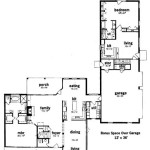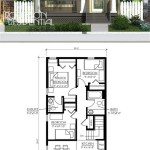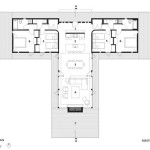Drawing house plans refers to the technical representation of architectural designs for residential projects. It involves creating scaled drawings that accurately depict the layout, dimensions, and various components of a house. These plans provide a blueprint for the construction and design process, ensuring that all aspects of the project are carefully planned and documented.
House plans are essential for obtaining building permits, estimating construction costs, and communicating the design vision to contractors and other stakeholders. They serve as a detailed guide that helps ensure the successful execution of the project, preventing costly errors or misinterpretations during the construction phase. By providing a visual representation of the design, house plans facilitate effective communication and coordination among all parties involved in the project.
When drawing house plans, it is important to consider the following key points:
- Scale and accuracy: Plans should be drawn to a precise scale, ensuring accurate measurements and dimensions.
- Floor plan layout: Clearly define the arrangement of rooms, hallways, and other spaces.
- Exterior elevations: Show the external appearance of the house from different sides.
- Structural details: Include details on framing, foundations, and other structural elements.
- Electrical and plumbing systems: Indicate the location of outlets, switches, plumbing fixtures, and pipes.
- Material specifications: Specify the materials to be used for walls, roofing, flooring, and other components.
- Site plan: Depict the house’s placement on the property, including landscaping and driveways.
- Building codes and regulations: Ensure compliance with local building codes and regulations.
Adhering to these points will help create comprehensive and accurate house plans that effectively guide the construction process.
Scale and accuracy: Plans should be drawn to a precise scale, ensuring accurate measurements and dimensions.
Scale refers to the ratio between the size of the drawing and the actual size of the building. Accurate scaling is crucial for ensuring that the dimensions and measurements depicted in the plans are precise and reliable. This accuracy is essential for several reasons:
- Construction accuracy: Contractors rely on house plans to determine the exact placement of walls, windows, doors, and other structural elements. Accurate scaling ensures that these elements are constructed in the correct locations and at the appropriate dimensions.
- Material estimation: Plans are used to calculate the quantities of materials required for construction, such as lumber, roofing, and siding. Accurate scaling ensures that these quantities are estimated correctly, preventing material shortages or surpluses.
- Cost estimation: Material quantities directly impact construction costs. Accurate scaling helps ensure that cost estimates are realistic and based on the actual dimensions of the house.
- Compliance with building codes: Building codes often specify minimum and maximum dimensions for certain structural elements, such as ceiling heights and room sizes. Accurate scaling helps ensure that the design meets these code requirements.
To achieve accurate scaling, architects and designers use a variety of tools and techniques. These include:
- Architectural scales: Predefined scales specifically designed for architectural drawings, such as 1/4″ = 1′-0″ (one-quarter inch equals one foot) or 1:100 (one unit on the drawing represents 100 units in real life).
- Computer-aided design (CAD) software: CAD programs allow designers to create digital house plans that can be scaled and modified easily and accurately.
- Manual scaling: Using a scale ruler or other measuring tools to manually determine the dimensions and measurements on the plans.
Regardless of the method used, maintaining accurate scaling is essential for creating house plans that are reliable, precise, and suitable for construction.
In addition to ensuring accuracy, precise scaling also facilitates effective communication among architects, contractors, and other stakeholders involved in the construction process. Clear and accurate plans help prevent misunderstandings and errors during construction, leading to a smoother and more efficient project execution.
Floor plan layout: Clearly define the arrangement of rooms, hallways, and other spaces.
The floor plan layout is a crucial aspect of house plans, as it determines the overall functionality and livability of the space. It involves arranging rooms, hallways, and other spaces in a logical and efficient manner, considering factors such as privacy, accessibility, and traffic flow.
- Room placement: The floor plan should carefully consider the placement of each room, taking into account its function, size, and relationship to other spaces. For example, bedrooms are typically placed in quieter areas of the house, while living rooms and kitchens are often located in more central and accessible locations.
- Hallways and circulation: Hallways serve as connectors between different rooms and spaces. The floor plan should ensure that hallways are wide enough for comfortable movement and that they provide clear and convenient access to all areas of the house.
- Traffic flow: The floor plan should facilitate smooth and efficient traffic flow throughout the house. It should minimize bottlenecks and ensure that there are no awkward or inconvenient paths of movement.
- Privacy and separation: The floor plan should consider the need for privacy in different areas of the house. Bedrooms and bathrooms, for example, should be designed to provide a sense of privacy and separation from other spaces.
Creating a well-designed floor plan layout requires careful planning and consideration of the specific needs and preferences of the homeowners. By thoughtfully arranging rooms and spaces, architects and designers can create houses that are both functional and enjoyable to live in.
Exterior elevations: Show the external appearance of the house from different sides.
Exterior elevations are drawings that depict the external appearance of a house from different sides, typically the front, back, and both sides. They provide a comprehensive view of the house’s exterior design, including the overall shape, rooflines, windows, doors, and other architectural features.
- Accurate representation: Exterior elevations should accurately represent the intended design of the house’s exterior. They should clearly show the proportions, dimensions, and relationships between different elements of the facade.
- Multiple perspectives: By providing multiple views of the house, exterior elevations allow architects and designers to showcase the house’s appearance from different angles. This helps homeowners visualize the house’s overall aesthetic and how it will look from various vantage points.
- Material and finish specifications: Exterior elevations often include specifications for the materials and finishes to be used on the exterior of the house. This information can include the type of siding, roofing, windows, and other materials, as well as their colors and textures.
- Compliance with building codes: Exterior elevations must comply with local building codes and regulations. This includes ensuring that the design meets requirements for setbacks, window placement, and other exterior features.
Well-drawn exterior elevations are essential for communicating the design intent to contractors and homeowners. They serve as a visual guide for the construction process, ensuring that the house’s exterior is built according to the architect’s vision.
Structural details: Include details on framing, foundations, and other structural elements.
Structural details are critical components of house plans, as they provide the technical specifications for the structural integrity and safety of the building. These details include information on framing, foundations, and other structural elements that ensure the house can withstand various loads and forces.
- Framing: Framing refers to the skeletal structure of the house, typically made of wood or steel. House plans should specify the type of framing, such as stick framing or platform framing, as well as the dimensions and spacing of framing members. This information ensures that the framing is strong enough to support the weight of the house and resist lateral forces like wind and seismic activity.
- Foundations: Foundations are the base of the house, anchoring it to the ground and transferring its weight to the soil. House plans should specify the type of foundation, such as a slab foundation, crawlspace foundation, or basement foundation. They should also include details on the depth, width, and reinforcement of the foundation, ensuring it can adequately support the house’s weight and prevent settling or structural issues.
- Beams and columns: Beams and columns are structural elements that support the weight of the house and transfer it to the foundation. House plans should specify the size, spacing, and materials used for beams and columns, ensuring they can handle the anticipated loads and forces.
- Shear walls and bracing: Shear walls and bracing are structural elements that resist lateral forces, such as wind and seismic forces. House plans should specify the location and design of shear walls and bracing, ensuring they provide adequate resistance to these forces and maintain the structural integrity of the house.
By including detailed structural information, house plans provide a clear and comprehensive guide for contractors to construct a safe and structurally sound house that meets building codes and regulations.
Electrical and plumbing systems: Indicate the location of outlets, switches, plumbing fixtures, and pipes.
Electrical and plumbing systems are essential components of a house, providing power, lighting, water supply, and waste disposal. House plans should clearly indicate the location of electrical outlets, switches, plumbing fixtures, and pipes to ensure proper installation and functionality of these systems.
- Electrical outlets and switches: House plans should specify the type, quantity, and location of electrical outlets and switches throughout the house. This includes outlets for appliances, lighting, and other electrical devices, as well as switches for controlling lights and fans.
- Lighting fixtures: House plans should also indicate the location and type of lighting fixtures, such as ceiling lights, wall sconces, and recessed lighting. This information helps ensure that the house has adequate lighting and that fixtures are placed in optimal locations for functionality and aesthetics.
- Plumbing fixtures: House plans should specify the location and type of plumbing fixtures, such as sinks, toilets, showers, and bathtubs. This information ensures that plumbing pipes and drains are properly routed and that fixtures are installed in accordance with building codes and regulations.
- Pipes and drains: House plans should include a layout of the plumbing pipes and drains, indicating their size, material, and routing. This information is crucial for ensuring that the plumbing system functions properly and that there is adequate water supply and drainage throughout the house.
By clearly indicating the location of electrical and plumbing systems, house plans provide a comprehensive guide for contractors to install these systems efficiently and effectively. This helps ensure that the house has a safe, functional, and well-integrated electrical and plumbing infrastructure.
Material specifications: Specify the materials to be used for walls, roofing, flooring, and other components.
Material specifications are an essential part of house plans, as they define the materials to be used for the construction of various components of the house. This includes specifying the materials for walls, roofing, flooring, siding, windows, doors, and other structural and aesthetic elements.
By specifying the materials in the house plans, architects and designers ensure that the house is constructed using materials that meet the desired aesthetic, durability, and performance requirements. Material specifications also help in estimating the cost of construction and ensuring that the project stays within the budget.
When specifying materials for walls, factors such as structural strength, insulation properties, fire resistance, and moisture resistance are considered. Common materials used for walls include wood, concrete, bricks, and steel. Roofing materials are chosen based on factors such as durability, weather resistance, and energy efficiency. Common roofing materials include asphalt shingles, metal roofing, and tile roofing.
For flooring, materials are selected based on factors such as durability, ease of maintenance, and aesthetic appeal. Common flooring materials include hardwood, laminate, tile, and carpet. Other materials, such as stone, vinyl, and cork, are also used for flooring in certain areas of the house. Material specifications for siding, windows, and doors are made based on factors such as durability, energy efficiency, and aesthetic compatibility with the overall design of the house.
By carefully specifying the materials to be used, house plans provide a detailed blueprint for the construction process, ensuring that the house is built using the right materials for optimal performance, durability, and aesthetic appeal.
Site plan: Depict the house’s placement on the property, including landscaping and driveways.
A site plan is a drawing that shows the house’s placement on the property, including its relationship to the lot lines, neighboring structures, driveways, walkways, and landscaping. It provides a comprehensive view of how the house fits into its surroundings and helps ensure that the design is feasible and meets local building codes and regulations.
- Property boundaries: The site plan should clearly indicate the property boundaries, including setbacks from the street and neighboring properties. This ensures that the house is placed within the allowable building envelope and complies with zoning requirements.
- Building footprint: The site plan shows the exact location and dimensions of the house on the property. It includes the overall shape, size, and orientation of the house, as well as the location of doors, windows, and other openings.
- Driveways and walkways: The site plan indicates the location and layout of driveways and walkways, providing access to the house from the street or other points of entry. It considers factors such as traffic flow, parking requirements, and accessibility.
- Landscaping: The site plan includes a landscaping plan that shows the placement of trees, shrubs, flower beds, and other landscaping features. This helps visualize the overall aesthetic appeal of the property and ensures that landscaping elements complement the house design.
A well-designed site plan is essential for obtaining building permits and ensuring that the house is constructed in accordance with local regulations. It also serves as a valuable tool for contractors during the construction process, helping them understand the overall layout of the property and the relationship between the house and its surroundings.
Building codes and regulations: Ensure compliance with local building codes and regulations.
Building codes and regulations are a set of standards and requirements established by local authorities to ensure the safety, structural integrity, and energy efficiency of buildings. When drawing house plans, it is imperative to adhere to these codes and regulations to obtain building permits, ensure the safety of occupants, and maintain the value of the property.
Building codes cover various aspects of construction, including structural design, fire safety, electrical and plumbing systems, accessibility, and energy efficiency. By complying with these codes, architects and designers can ensure that the house is designed and built to withstand anticipated loads, resist fire, and provide a safe and healthy living environment.
Local building codes often specify minimum requirements for structural elements such as foundations, framing, and roofing. They also regulate the installation of electrical and plumbing systems, ensuring that they meet safety standards and minimize the risk of electrical hazards or water damage.
Furthermore, building codes address energy efficiency measures, such as insulation levels, window performance, and HVAC system efficiency. Compliance with these regulations helps reduce energy consumption, lower utility costs, and contribute to environmental sustainability.
By incorporating building codes and regulations into house plans, architects and designers create safe, habitable, and energy-efficient homes that meet the requirements of local authorities and ensure the well-being of occupants.










Related Posts








